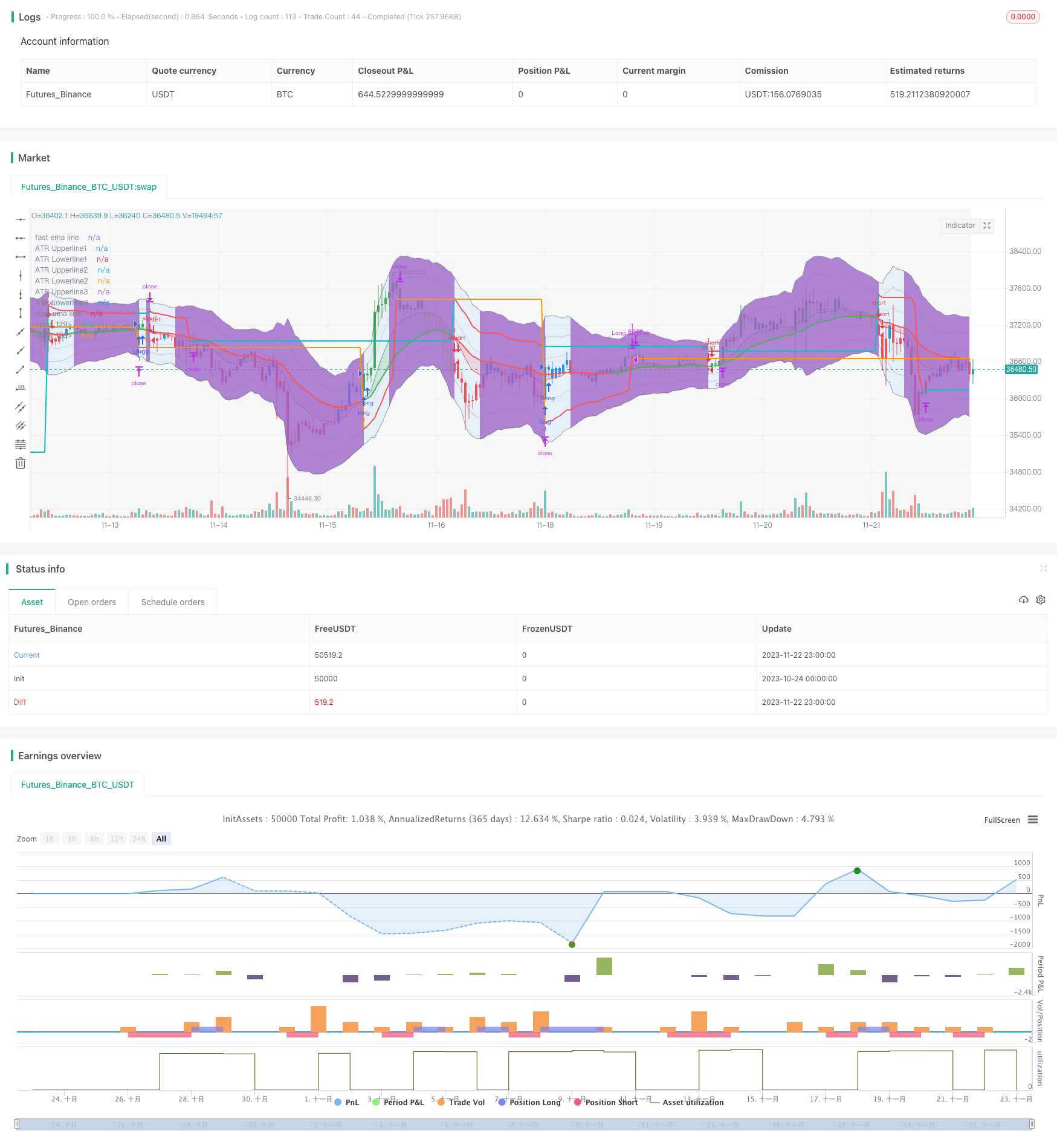
概述
本策略主要思想是结合动能区和ATR指标,在出现金叉时做多,出现死叉时做空。同时设置止损和止盈价格。当价格出现反转信号时,会反向开仓,实现反转订单的功能。
原理
- 使用快速EMA和慢速EMA计算多空信号。快速EMA高于慢速EMA为看涨,反之为看跌。
- 在无仓位时,出现金叉就做多,出现死叉就做空。
- 已开仓时,若出现反转信号,会先平掉当前仓位,再按相反方向开新仓。
- 使用ATR指标计算止损和止盈价格。止损价格会根据ATR通道进行调整,确保止损风险小。
- 当价格进入超买超卖区域时,会调整止损价格为最后一根K线的最高价或最低价,避免被套。
优势
- 结合动能区和ATR,能够在趋势中顺势开仓,又能定时止损止盈。
- 实现反转订单功能,能够在价格反转时快速切换方向,充分利用价格双向波动获得更高收益。
- ATR止损机制能够有效控制单笔止损风险,整体实现高胜率。
- 结合超买超卖判定,避免被突发事件套住。
风险及解决
- 反转订单在震荡行情中可能过于频繁交易,增加交易成本和止损几率。
- 解决:增加最小持仓周期,在震荡行情中减少反转。
- ATR值变化可能令止损范围过大或过小。
- 解决:根据ATR值实时调整止损距离。
- 参数设置不当可能导致交易频率过高或信号效果不佳。
- 解决:根据不同品种合理选择参数组合。
优化方向
- 优化参数设置,寻找最佳参数组合。
- 增加辅助技术指标过滤,提高信号质量。
- 增加资金管理模块,使仓位与账户总资产挂钩。
- 增加跨时间周期分析,利用更多信息提升策略效果。
总结
本策略整合动能区和ATR指标的优势,实现高效双向交易。反转订单机制及ATR智能止损,能够充分利用价格波动。优化参数设置和结合更多指标可进一步提高策略效果。本策略适合高频双向交易,也可作为辅助决策工具。
策略源码
/*backtest
start: 2023-10-24 00:00:00
end: 2023-11-23 00:00:00
period: 1h
basePeriod: 15m
exchanges: [{"eid":"Futures_Binance","currency":"BTC_USDT"}]
*/
// This source code is subject to the terms of the Mozilla Public License 2.0 at https://mozilla.org/MPL/2.0/
// © fenirlix
//@version=5
// Strategy parameter incl. position size, commission and initial capital
strategy("ACTIONZONE-ATR REVERSEORDER STRATEGY", "ACTIONZONEATR-REVERSEORDER", overlay=true
)
// User Input Variable
fastMaInput = input.int(12, "Fast MA Period", minval=2, step=1)
slowMaInput = input.int(26, "Fast MA Period", minval=2, step=1)
atrLengthInput = input.int(14, "ATR length", minval=2,step=1)
atrInnerMultInput = input.float(1, "atr inner multiplier", minval=0.1, step=0.1)
atrMidMultInput = input.float(2, "atr inner multiplier", minval=0.1, step=0.1) //***** MOST OF RISK MANAGEMENT LOGIC BASE ON THIS INPUT *****//
atrOuterMultInput = input.float(3, "atr inner multiplier", minval=0.1, step=0.1)
// Backtesting Date range
startYearInput = input.int(2021, "Start Year", minval=1900, maxval=2100, step=1)
startMonthInput = input.int(12, "Start Month", minval=1, maxval=12, step=1)
startDateInput = input.int(1, "Start Day", minval=1, maxval=31, step=1)
setEndRangeInput = input.bool(false, "Using Specific End Test Date") //Set specific End date or use present(end of candle) data
endYearInput = input.int(2022, "End Year", minval=1900, maxval=2100, step=1)
endMonthInput = input.int(1, "End Month", minval=1, maxval=12, step=1)
endDateInput = input.int(31, "End Day", minval=1, maxval=31, step=1)
startDate = timestamp(syminfo.timezone, startYearInput, startMonthInput, startDateInput)
endDate = timestamp(syminfo.timezone, endYearInput, endMonthInput, endDateInput)
inDateRange = time >= startDate //Set backtest date range to present data
if setEndRangeInput
inDateRange and time <= endDate //set backtest date range to specific date
// minimum position hold period (to get rid of false signal in sideway trend)
minHoldInput = input.int(8, 'Minimum position Hold Limit', minval=1, maxval=365, step=1) // Set Minimum Position Hold
var bool reverseToLong = false // Assign reverse order operator
var bool reverseToShort = false // Assign reverse order operator
// Indicator Declaration
fastEma = ta.ema(close, fastMaInput)
slowEma = ta.ema(close, slowMaInput)
atr = ta.atr(atrLengthInput)
// Declare trend of asset
isBullish = fastEma > slowEma
isBearish = fastEma <= slowEma
// Record position hold length, to limit minimum hold period(candle)
var int hold_length = 0
if strategy.opentrades > 0 or strategy.opentrades < 0
hold_length := hold_length + 1
else
hold_length := 0
// create permanent variable of stop price
var float longStopPrice = na
var float shortStopPrice = na
// Chart-Indicator COLOR declaration
REDBEAR = color.new(color.red, 80)
GREENBULL = color.new(color.green, 80)
greenLong = isBullish and close > fastEma
yellowLong = isBullish and close < fastEma
blueShort = isBearish and close > fastEma
redShort = isBearish and close < fastEma
// assign oversold, overbought condition(in this case, price over middle atr plus/minus fastEma)
overBand = high[1] > fastEma + (2*atr)
underBand = low[1] < fastEma - (2*atr)
// Strategy
// Main Entry Condition
goLong = isBullish and isBullish[1] == 0
goShort = isBearish and isBearish[1] == 0
inPosition = strategy.position_size != 0
minHoldPeriod = hold_length > minHoldInput ? true : false
// Entry Condition
if not inPosition and inDateRange and barstate.isconfirmed == true //compute after close of the bar to avoid repainting
if goLong or reverseToLong // Long if longcondition or reverse order receive.
strategy.entry('long', strategy.long)
longStopPrice := fastEma - (atr * 2) // Set stop loss price
reverseToLong := false // Reset reverse order status
else if goShort or reverseToShort
strategy.entry('short', strategy.short)
shortStopPrice := fastEma + (atr * 2)
reverseToShort := false
// Take profit and Set Higher Stop
if inPosition and minHoldPeriod and barstate.isconfirmed == true // check if we're in position and pass minimum hold period, confirm no repainting
if strategy.position_size > 0
// if exit position by Sellcondition(which is the same as ShortCondition), Exit Long position and make Short order(by set reverse order to true)
strategy.close('long', when=goShort, comment='exitLong(' + str.tostring(hold_length) + ')')
reverseToShort := true
if overBand //If overbought condition met, set Stop price to LAST LOW, and not reverse any position
longStopPrice := low[1]
reverseToShort := false
else if strategy.position_size < 0
strategy.close('short', when=goLong, comment='exitShort(' + str.tostring(hold_length) + ')')
reverseToLong := true
if underBand
shortStopPrice := high[1]
reverseToLong := false
// Stop Loss and Set calculate stop loss using Atr Channel
if inPosition
if strategy.position_size > 0
if fastEma - (atr * atrMidMultInput) > longStopPrice // set long stop price to the higher of latest long stop price and ATR lower channel
longStopPrice := fastEma - (atr * atrMidMultInput)
strategy.exit('Long Stop atr ', 'long', stop=longStopPrice)
else if strategy.position_size < 0
if fastEma + (atr * atrMidMultInput) < shortStopPrice
shortStopPrice := fastEma + (atr * atrMidMultInput)
strategy.exit('Short Stop atr ', 'short', stop=shortStopPrice)
// Plotting
fastLine = plot(fastEma, title='fast ema line', linewidth=1, color=isBullish ? color.green : color.red)
slowLine = plot(slowEma, title='slow ema line', linewidth=2, color= isBullish? color.green : color.red)
atrUpperLine1 = plot(fastEma + (atr * atrInnerMultInput), title='ATR Upperline1', color=color.new(color.black,85))
atrLowerLine1 = plot(fastEma - (atr * atrInnerMultInput), title='ATR Lowerline1', color=color.new(color.black,85))
atrUpperLine2 = plot(fastEma + (atr * atrMidMultInput), title='ATR Upperline2', color=color.new(color.black,75))
atrLowerLine2 = plot(fastEma - (atr * atrMidMultInput), title='ATR Lowerline2', color=color.new(color.black,75))
atrUpperLine3 = plot(fastEma + (atr * atrOuterMultInput), title='ATR Upperline3', color=color.new(color.black,50))
atrLowerLine3 = plot(fastEma - (atr * atrOuterMultInput), title='ATR Lowerline3', color=color.new(color.black,50))
plot(longStopPrice, color=strategy.position_size > 0 ? color.red : na, linewidth=2)
plot(shortStopPrice, color=strategy.position_size < 0 ? color.red : na, linewidth=2)
// Filling
fill(fastLine, slowLine, color=isBullish ? GREENBULL : REDBEAR)
fill(atrUpperLine3, atrLowerLine3, color=inPosition and (minHoldInput - hold_length > 0) ? color.new(color.blue,90): na)
barColor = switch
greenLong => color.green
yellowLong => color.yellow
blueShort => color.blue
redShort => color.red
=> color.black
barcolor(color=barColor)
// Fill background to distinguish inactive time(Zulu time)
nightTime = time(timeframe.period, "1500-0100") ? color.new(color.black, 95): na
bgcolor(nightTime)